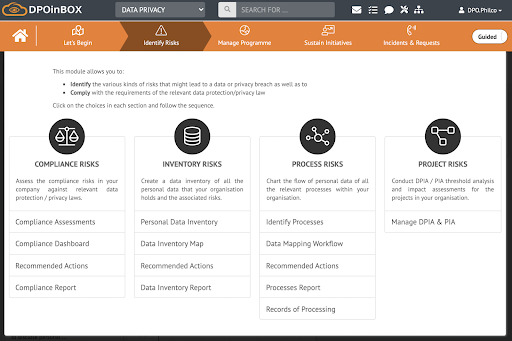Data protection regulations have come into effect in a lot of jurisdictions. With this development, organisations must be able to translate the requirements of the law into their business practices. Identifying risk areas and addressing any gaps in the organisation's security system is, hence, important for businesses when it comes to protecting data within their organisation.
Sources of risks
Where are your data protection risks?
Data protection regulations set out the principles and rules by which organisations need to govern the processing of personal data. Almost all privacy and data protection regulations take a risk management approach to the protection of personally identifiable information. In this approach, the starting point for companies to create an effective data protection management programme or system is by identifying the key sources of risks.
Under privacy and data protection, there are four main areas of risk:
- Regulatory compliance requirements
- Personal data inventory
- Business processes that involve personal data
- New projects such as new applications, new systems, new activities which process personal information

Screenshot of risks from DPOinBOX
Upon identification of these data protection risk areas, the organisation must also implement controls and measures to close these gaps, in order to protect data and ensure the effectiveness of the organisation's data protection management programme.
Compliance
An important driver when it comes to implementing the data protection management programme in an organisation is compliance with data protection laws. The ISO 37301 defines compliance as “a systematic approach designed to ensure that an organisation meets its obligations under all applicable laws, regulations, best practices and standards, contractual obligations and institutional policies”.
Organisations need to put in place a privacy and data protection management system that assesses the sources of risks, protect the data subjects and the organisation, sustain it by monitoring, auditing and training employees and also allows the organisation to respond to security incidents and data breaches efficiently when it occurs.
Opportunities
There are many benefits to having a robust data protection management programme. An effective privacy and data protection management programme can provide some of the following opportunities/benefits:
- Optimise business processes that support business objectives
- Reduce costs by reducing work duplication and redundant tasks
- Earn trust from stakeholders by being transparent and prudent in the processing of personal data

Conclusion
A privacy and data protection management programme can translate the various areas of risks of the organisation into key opportunities. A privacy information management system is a business enabler that provides companies with the opportunity to put customers (as data subjects) into the centre of their operations through the assessment of their business practices. It is also useful for organisations to adopt software such as DPOinBOX with the capabilities to log in risks as part of their data protection management programme.
If you’re interested in finding out more, join us in our 5 July webinar that will demonstrate how our DPOinBOX software can transform your organisation’s privacy and data protection journey.
Article By: Edwin Concepcion, FIP, CIPM, CIPT, CIPP/E, CIPP/US
The views and opinions expressed in this article are those of the author and do not necessarily reflect the official view or position of DPEX Network.